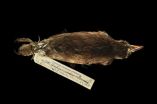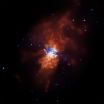The best way to measure dark energy just got better
2011-01-14
(Press-News.org) Dark energy is a mysterious force that pervades all space, acting as a "push" to accelerate the Universe's expansion. Despite being 70 percent of the Universe, dark energy was only discovered in 1998 by two teams observing Type Ia supernovae. A Type 1a supernova is a cataclysmic explosion of a white dwarf star.
These supernovae are currently the best way to measure dark energy because they are visible across intergalactic space. Also, they can function as "standard candles" in distant galaxies since the intrinsic brightness is known. Just as drivers estimate the distance to oncoming cars at night from the brightness of their headlights, measuring the apparent brightness of a supernova yields its distance (fainter is farther). Measuring distances tracks the effect of dark energy on the expansion of the Universe.
The best way of measuring dark energy just got better, thanks to a new study of Type Ia supernovae led by Ryan Foley of the Harvard-Smithsonian Center for Astrophysics. He has found a way to correct for small variations in the appearance of these supernovae, so that they become even better standard candles. The key is to sort the supernovae based on their color.
"Dark energy is the biggest mystery in physics and astronomy today. Now, we have a better way to tackle it," said Foley, who is a Clay Fellow at the Center. He presented his findings in a press conference at the 217th meeting of the American Astronomical Society.
The new tool also will help astronomers to firm up the cosmic distance scale by providing more accurate distances to faraway galaxies.
Type Ia supernovae are used as standard candles, meaning they have a known intrinsic brightness. However, they're not all equally bright. Astronomers have to correct for certain variations. In particular, there is a known correlation between how quickly the supernova brightens and dims (its light curve) and the intrinsic peak brightness.
Even when astronomers correct for this effect, their measurements still show some scatter, which leads to inaccuracies when calculating distances and therefore the effects of dark energy. Studies looking for ways to make more accurate corrections have had limited success until now.
"We've been looking for this sort of 'second-order effect' for nearly two decades," said Foley.
Foley discovered that after correcting for how quickly Type Ia supernovae faded, they show a distinct relationship between the speed of their ejected material and their color: the faster ones are slightly redder and the slower ones are bluer.
Previously, astronomers assumed that redder explosions only appeared that way because of intervening dust, which would also dim the explosion and make it appear farther than it was. Trying to correct for this, they would incorrectly calculate that the explosion was closer than it appeared. Foley's work shows that some of the color difference is intrinsic to the supernova itself.
The new study succeeded for two reasons. First, it used a large sample of more than 100 supernovae. More importantly, it went back to "first principles" and reexamined the assumption that Type Ia supernovae are one average color.
The discovery provides a better physical understanding of Type Ia supernovae and their intrinsic differences. It also will allow cosmologists to improve their data analysis and make better measurements of dark energy - an important step on the road to learning what this mysterious force truly is, and what it means for the future of the cosmos.
INFORMATION: END
ELSE PRESS RELEASES FROM THIS DATE:
2011-01-14
The following highlights summarize research papers that have been recently published in Geophysical Research Letters (GRL).
In this release:
Spooky action at a distance, for earthquakes
Evidence for water ice near the Martian equator
Extraordinary uplift of Yellowstone caldera
New evidence could let supereruption off the hook
Auroral oscillations seen on Saturn
How much sea-level rise can coastal marshes withstand?
Rain affects carbon-dioxide flow between sky and sea
Ionosphere model overshoots during solar minimum
Anyone may read the scientific abstract for ...
2011-01-14
MANHATTAN, KAN. -- At any given time between 10 and 20 percent of cattle in the United States are afflicted with lameness, making it one of the most common ailments affecting feedlot and stocker calves.
That's why a Kansas State University research team is working to reduce the percentage of cattle affected by bovine lameness.
Three researchers -- David Anderson, professor of clinical sciences; Brad White, associate professor of clinical sciences; and Johann Coetzee, associate professor of clinical sciences -- are involved with bovine pain and welfare assessment at ...
2011-01-14
BATON ROUGE – The Crab Nebula, once considered to be a source of energy so stable that astronomers used it to calibrate their instruments, is dimming. LSU physicists Mike Cherry, Gary Case and graduate student James Rodi, together with an international team of colleagues using the Gamma-ray Burst Monitor, or GBM, on NASA's Fermi gamma-ray space telescope, discovered the anomaly. This revelation has proven astonishing for astronomers.
The Crab Nebula, one of the most studied objects in the sky, is the wreckage of a star that exploded in 1054. Considered a cornerstone of ...
2011-01-14
A research team from across the United States and Ecuador has pinpointed 1898 as the year the avipoxvirus, or avian pox, hit the Galapagos Islands and started infecting its birds. This estimation is vital to understanding avian diseases that affect today's Galapagos birds. The scientists' paper on the subject, "110 Years of Avipoxvirus on the Galapagos Islands," will be published on January 13 in PLoS ONE, an international, open-access science publication.
The research team, led by Dr. Patricia Parker of the University of Missouri–St. Louis, examined 3,607 finches and ...
2011-01-14
A new Chandra X-ray Observatory image of Messier 82, or M82, shows the result of star formation on overdrive. At a distance of only 12 million light years, M82 provides a unique cosmic laboratory for studying conditions similar to those that existed billions of years ago when stars were forming at a furious rate in most galaxies.
M82 is a so-called starburst galaxy, where stars are forming at rates that are tens or even hundreds of times higher than in a normal galaxy. The burst of star birth may be caused by a close encounter or collision with another galaxy, which ...
2011-01-14
DURHAM, N.C. — Researchers at the Duke Cancer Institute who have been studying prostate cancer cells for decades now think they know why PSA (prostate-specific antigen) levels reflect cancer progression.
"This is the first demonstration of a mechanism that explains why PSA is a bad thing for a tumor to produce," said senior author Sal Pizzo, M.D., Ph.D., chair of the Duke Department of Pathology. "I am willing to bet there is also a connection in cancerous cell growth with this particular biological signaling mechanism happening in other types of cells."
Using human ...
2011-01-14
GALVESTON, TX – Drugs that pharmaceutical companies market most aggressively to physicians and patients tend to offer less benefit and more harm to most patients — a phenomenon described as the "inverse benefit law" in a paper from the University of Texas Medical Branch at Galveston.
Published online Thursday, Jan. 13 in the American Journal of Public Health, the article explores recent withdrawals of blockbuster drugs due to safety concerns and finds a clear pattern of physician-focused marketing tactics that ultimately exposed patients to a worsening benefit-to-harm ...
2011-01-14
The American Heart Association today issued a call to action for the public, health professionals, the food industry and the government to intensify efforts to reduce the amount of sodium (salt) Americans consume daily.
In an advisory, published in Circulation: Journal of the American Heart Association, the association sets out the science behind the American Heart Association's recommendation for the general population, which is to consume no more than 1500 milligrams (mg) of sodium a day because of the harmful effects of sodium – elevated blood pressure and increased ...
2011-01-14
New NASA satellite data indicate the current La Niña event in the eastern Pacific has remained strong during November and December 2010.
A new Ocean Surface Topography Mission (OSTM)/Jason-2 satellite image of the Pacific Ocean that averaged 10 days of data was just released from NASA. The image, centered on Dec. 26, 2010, was created at NASA's Jet Propulsion Laboratory (JPL), Pasadena, Calif.
"The solid record of La Niña strength only goes back about 50 years and this latest event appears to be one of the strongest ones over this time period," said Climatologist Bill ...
2011-01-14
The bodies of virtually all U.S. pregnant women carry multiple chemicals, including some banned since the 1970s and others used in common products such as non-stick cookware, processed foods and personal care products, according to a new study from UCSF.
The study marks the first time that the number of chemicals to which pregnant women are exposed has been counted.
Analyzing data for 163 chemicals, researchers detected polychlorinated biphenyls (PCBs), organochlorine pesticides, perfluorinated compounds (PFCs), phenols, polybrominated diphenyl ethers (PBDEs), phthalates, ...
LAST 30 PRESS RELEASES:
[Press-News.org] The best way to measure dark energy just got better


